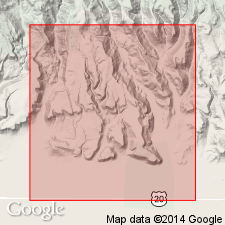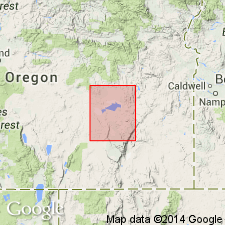
- Usage in publication:
-
- Danforth formation*
- Modifications:
-
- Named
- Dominant lithology:
-
- Breccia
- Terrigenous clastics
- Rhyolite
- AAPG geologic province:
-
- Southern Oregon basin
Summary:
Pg. 10. Danforth formation. Unconformably overlies Steens basalt; unconformably underlies Harney formation (new). Thickness 20 to 800 feet. In southern part of area, consists of four facies: tuff-breccia and associated stratified rocks; basaltic breccia and associated siltstone, sandstone, conglomerate, and two intercalated sheets of basalt; stratified siltstone, sandstone, and ash; and spherulitic rhyolite. In northwestern part of area, formation comprises, in upper part, stratified siltstone, sandstone, tuff, and volcanic ash with intercalated layers of glassy perlitic rhyolite and one rhyolitic tuff-breccia layer; lower part massive rhyolite. Recognized in southeastern Oregon. Age is Pliocene.
Name derived from Danforth Ranch in T. 22 S., R. 32 1/2 E., where section is exposed along Cow Creek, Harney Co., southeastern OR.
Source: US geologic names lexicon (USGS Bull. 1200, p. 1040).

- Usage in publication:
-
- Danforth formation*
- Modifications:
-
- Overview
- AAPG geologic province:
-
- Southern Oregon basin
Summary:
Pg. 43-49, pl. 2. Danforth formation. Detailed description. [This is report cited in Wilmarth Lexicon (USGS Bull. 896) as "in press."]
Source: US geologic names lexicon (USGS Bull. 1200, p. 1041).
For more information, please contact Nancy Stamm, Geologic Names Committee Secretary.
Asterisk (*) indicates published by U.S. Geological Survey authors.
"No current usage" (†) implies that a name has been abandoned or has fallen into disuse. Former usage and, if known, replacement name given in parentheses ( ).
Slash (/) indicates name conflicts with nomenclatural guidelines (CSN, 1933; ACSN, 1961, 1970; NACSN, 1983, 2005, 2021). May be explained within brackets ([ ]).

